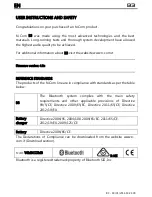
CT6 Cadillac User Experience (GMNA-Localizing-U.S./Canada-11292518) -
2018 - crc - 3/1/17
80
VOICE RECOGNITION
waiting for the prompt to
complete, press
g
again and wait
for the beep.
.
Speak the command naturally, not
too fast, not too slow. Use direct
commands without a lot of extra
words.
.
Usually Phone and Audio
commands can be spoken in a
single command.
For example,
“
Call <name> at
work,
” “
Play
”
followed by the artist
or song name, or
“
Tune
”
followed
by the radio station number.
.
Navigation destinations are too
complex for a single command.
First, state a command that
explains the type of destination
needed, such as I want directions
to an
“
Address,
” “
Navigate to an
intersection,
” “
I need to find a
Place of Interest or POI,
”
or
“
Directions to a Contact.
”
The
system responds with requesting
more details. After saying
“
Place of
Interest,
”
only major chains are
available by name. Chains are
businesses with at least 20
locations. For other POIs, say the
name of a category like
“
Restaurants,
” “
Shopping Malls,
”
or
“
Hospitals.
”
Most languages do not support
natural language commands in
sentence form. For those languages,
use direct commands like the
examples shown on the display.
There is no need to memorize specific
command words. Direct commands
might be more clearly understood by
the system. An example of a direct
command would be
“
Call <number>.
”
Examples of these direct commands
show on most of the displays while a
voice session is active. If
“
Phone
”
or
“
Phone Commands,
”
is stated, the
system understands that a phone call
is requested and will respond with
questions until enough details are
gathered.
If the phone number has been saved
with a name and a place, the direct
command should include both, for
example
“
Call <name> at work.
”
Using Voice Recognition for List
Options
When a list is displayed, a voice
prompt will ask to confirm or select
an option from that list. A selection
can be made by manually selecting
the item, or by speaking the line
number for the item to select.
When a screen contains a list, there
may be options that are available but
not displayed. The list on a voice
recognition display functions the same
as a list on other displays. Scrolling or
flinging can be used to help display
other entries from the list.
Manually scrolling or paging the list
on a display during a voice
recognition session suspends the
current voice recognition event and
plays the prompt
“
Make your selection
from the list using the manual
controls, touch the Back icon on the
infotainment display to try again.
”
If manual selection takes more than
15 seconds, the session terminates
and prompts that it has timed out.
The display returns back to the
display where voice recognition was
initiated.
















































